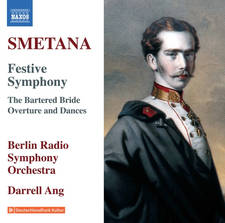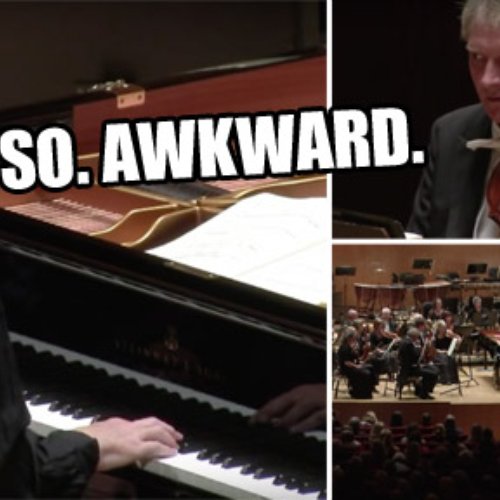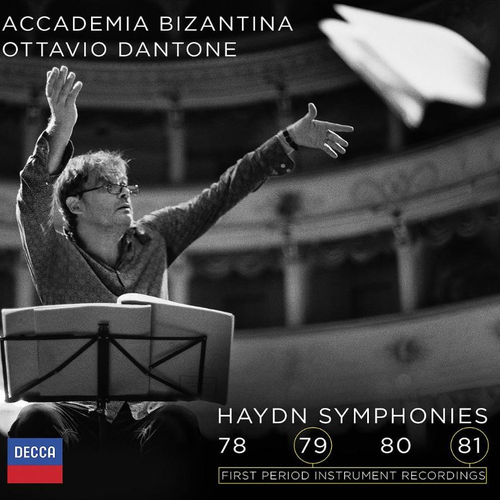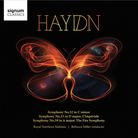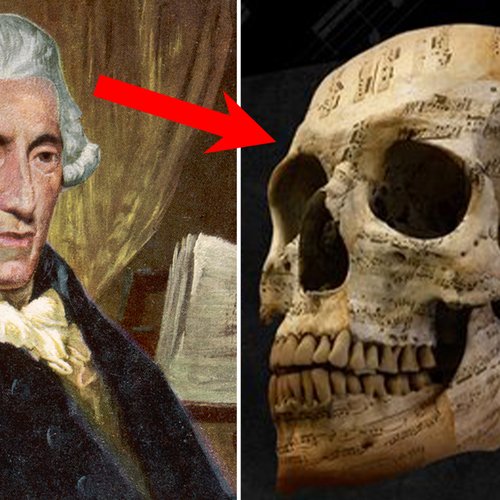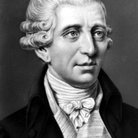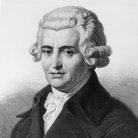We made this guy listen to all 104 Haydn symphonies and put them in order of greatness
11 January 2016, 10:45 | Updated: 3 January 2017, 16:41

It’s taken an extremely long time and it almost sent our writer mad, but we’ve created one of the most important documents in classical music.
Hi(dn).
I was given the ridiculous task of listening to all of Haydn's 104 symphonies and putting them in order of brilliance (or not-so-brilliance). Look how happy I was about it:

Over the ensuing several work days of Haydn-heavy interaction, I went a bit weird in the head. To my colleagues, I apologise for your having to sit next to this:

NB: I didn’t bother with any un-numbered or newly-discovered symphonies. Sorry.
Let the countdown commence!
104. Symphony No. 4
Confusing filler. There’s a bit of ploddy syncopation in the second movement to get your pulse back to a sentient level, but aside from that there’s little to get truly excited about.
103. Symphony No. 9
A bit of an autopilot symphony. At this relatively early stage in his career, Haydn clearly knows what he’s doing and is still smashing out melodies like there’s no tomorrow, his symphonies are becoming interchangeable. Honestly, swap a movement out for another one from Symphony No. 4. Literally no-one would notice.
102. Symphony No. 15
Real talk: the opening to this symphony is deathly. Long, uninventive and positively backwards-looking. There are flashes of inspiration elsewhere, sort-of, but generally you assume that this was being composed alongside a lot of other, more important works. Should’ve stayed in the desk-drawer.
101. Symphony No. 12
You could describe the opening movement as a fun bit of fluff and everything after it composing-by-numbers, especially the ponderous second movement. Trouble is, by this point, around 1763, Haydn was pretty much constantly knocking out symphonies with his eyes closed, which means a large chunk of that early output is pretty forgettable. Not without interest, but there’s so much better to come.
100. Symphony No. 32
Early-mid-period filler. Skip over.
99. Symphony No. 5
After a subdued opening and some neat, wincingly high horn entries, this one sort-of fails to go anywhere. It is a delight to listen to, sure, but it’s an ephemeral pleasure that doesn’t last as long as it might. An early sign of huge promise, but one that lacks maturity.
98. Symphony No. 36
Not a classic. Winsome and pleasant enough, but it suffers from another quite tawdry slow movement.
97. Symphony No. 62
Allow it to wash over you and you’ll be fine. Try to remember any of the melodies and you’ll be staring into the void. Tepid.
96. Symphony No. 18
The symphonies that open in slow tempo tend to fall into two camps when it comes to Haydn - spectral beauty, or a meandering plod. Sadly, this is the latter. It’s difficult to establish any kind of momentum, but there are chunks of the final movement that elevate the whole work higher than a complete throwaway.
95. Symphony No. 43 (‘Mercury’)
No obvious reason for the subtitle. Almost exactly the same opening as No. 42 (BANG-quiet, BANG-quiet). Despite these annoyances, there’s some proto-Mozart string work going on here, especially in the first movement. The second movement is, however, an absolutely transparent whopper. 10 minutes of politeness.
94. Symphony No. 23
More auto-pilot. Perhaps the most fun to be had with this one is to count the five-note semiquaver runs in the second movement. There’s like a billion of them. Either side of that, not much.
93. Symphony No. 55 (‘The Schoolmaster’)
Supposedly the nickname of this symphony comes from the second movement, which sounds like a schoolmaster wagging his finger and falling in love. We don’t buy it.
92. Symphony No. 85 (‘La Reine’)
Not a pizza. Disappointing.
91. Symphony No. 37
Another chronologically mislabeled symphony. Do not be fooled: it’s a fairly boring early one.
90. Symphony No. 50
After a run of some really strong symphonies throughout the ‘40s, no. 50 is a total squelch. Stately, boring, fusty, disappointing. There are some impressive athletics in the strings in the first movement, but it’s as if Haydn’s totally forgotten the amazing music he’d only recently composed in his Sturm und Drang period.
89. Symphony No. 1
It opens with a nifty, nippy crescendo, but then doesn’t do very much at all. Promising, but disappointing. Still, it was only his first (numbered) stab at a symphony, so we’ll forgive. Unless you look a bit more closely at the chronology of what was composed when, in which case that argument falls apart. No-one's here for accuracy.
88. Symphony No. 41
A grind. Why won’t he let rip? There’s potential in the first movement, pent-up energy, even, but Haydn just won’t open up in the same way he does in, say, 39 or 26.
87. Symphony No. 56
One of Haydn’s longest at over half an hour, but does he manage to fill it with enough decent tunes? Well… aside from some neat and intricate small ensemble work in the third movement, there’s not a whole lot to write home about in 56. You’ve heard these themes before, in one form or another.
86. Symphony No. 17
If you were to listen to Haydn’s symphonies in chronological order, no. 17 would be about the point where you’d consider giving up. There’s nothing wrong with it, but it’s one of the most inconspicuous. Nice melodies, the odd rhythmic tweak or structural innovation, but nothing more.
85. Symphony No. 68
Haydn the joker returns, mucking about with accents in the minuet and trio to give the illusion of a wonky downbeat. Well, it’s funny to musos, anyway. Trouble is, when he gets preoccupied with these little games, it can detract from the impact of the symphony as a whole, leaving one with little memory of the main themes.
84. Symphony No. 24
Woodwind to the fore here, but Haydn hadn’t really worked out quite what to do with them all at this point in his career. So while it’s entertaining to hear them fight it out with the strings for ‘most important section’, it’s a bit confusing.
83. Symphony No. 40
Numbered 40, but actually dates from the early teens. Fairly passable. Haydn phoning it in, no major stylistic tics or inventions.
82. Symphony No. 16
There’s an impressive cello ‘moment’ here in the middle movement that earmarks the instrument as one of Haydn’s favourites. Not challenging technically, but to nail that lyricism is a rare and satisfying thing.
81. Symphony No. 7 (‘Le midi’)
The afternoon, eh? Must’ve been a long one. Even with only seven symphonies to his name, Haydn was using every trick in the book to extend his melodies. Though the melodies are undoubtedly fine, they are also languorous, slow, and perhaps overly dainty.
80. Symphony No. 66
If we were making a movie with the first movement of this symphony as a soundtrack, it would be a whimsical comedy starring Cameron Diaz as a beleaguered ‘always the bridesmaid’-type character. Maybe a cameo from Zac Efron.
79. Symphony No. 3
Uh-oh, time for an innovation! Haydn eschewed the traditional three-movement structure here in place of a four-movement epic, with plenty of little intricacies to keep symphony-nuts entertained, like a finale that squashes a fugue into sonata form.
78. Symphony No. 38 (‘Echo’)
Basically a gimmick. Nice enough tunes, but using mutes on the second violins when they answer the unmuted firsts is a bit of a cheap gag, even for Haydn.
77. Symphony No. 52
The grumpy opening here immediately suggests that the melancholy of Haydn’s middle period had evolved a little. The character changes sometimes violently here, veering from sprightly to angry within the space of a few horn stabs. It’s entertaining, for sure, but the emotional through-line isn’t quite as clear as it could be.
76. Symphony No. 58
After the righteous anger and heartfelt melancholy of the 40s, the 50s seems to be Haydn’s rather less exciting comedown. 58 is pleasant enough, but there must’ve been a legion of music lovers at the time who were willing him to recapture the magic of his previous glories. There’s even some musical dragging here, as Haydn hobbles the minuet with incessant dotted rhythms.
75. Symphony No. 48 (‘Maria Therese’)
The Holy Roman Empress Maria Therese was probably scared stiff by those opening horns. A bit polite and ceremonial when we know Haydn was capable of much deeper, darker emotions.
74. Symphony No. 29
OK, so there’s a weird thing about the melody in the third movement - basically, it’s supposed to be improvised by the harpsichord, but generally people don’t bother to put it in. So it’s hard to imagine exactly what this symphony would’ve sounded like in its day. Still, it’s what you might call a hallmark Haydn symphony, a step up from mere filler but not among the top flight.
73. Symphony No. 47 (‘Palindrome’)
Is this the ultimate Haydn joke? The third movement, the minuet and trio, takes its initial melody and then plays it in reverse, which gives the symphony its name. Oh how they must have laughed, those 18th century boffins, as they caught wind of Haydn’s little game. But is the symphony actually any good? Well, it’s alright.
72. Symphony No. 33
The viola, of all things, comes to the fore here, as Haydn gives it its own voice in the first movement here. It’s another of his stylistic tics, little amusements that he incorporated no-doubt to entertain himself as much as the audience. Not a classic, but solid enough.
71. Symphony No. 69 (‘Laudon’)
By the time he got to no. 69, there was no more melancholy in Haydn’s music and he churned out sprightly little chuffers like this one. Great, shivery triplets in the first movement, and a power-pop finale. A little by-the-numbers, perhaps, but the numbers are quite good.
70. Symphony No. 19
Wistful and bracing at the outset, then a little dismal in the middle, then back to being bracing at the end. The bookend movements here are strong, but the middle is a bit of a plod.
69. Symphony No. 57
Another 30 minute+ symphony, but this time, it doesn’t seem like the ideas are stretched to breaking point. Tolerably exhausting, like a strenuous playfight with an older sibling.
68. Symphony No. 83 (‘The Hen’)
Literally nothing in this symphony sounds like a hen. But once you’re over that minor etymological hurdle, there are some winsome, outdoorsy melodies to tramp through, none of which will tax the brain or the ears too much.
67. Symphony No. 10
Once again showing Haydn’s penchant for brevity when necessary, this 15 minuter still only comes to life in the finale. If you find a recording that foregrounds the continuo in that closing Presto, this is a right belter.
66. Symphony No. 94 (‘Surprise’)
That super-loud chord in the second movement! SURPRISE! Except it’s not surprising because literally everyone knows it’s coming. It’s still an enjoyable symphony, but mostly because the Germans call it ‘mit der Paukenschlag’ (‘with the kettledrum stroke’).
65. Symphony No. 77
If you’re the sort of person who has a soundtrack in their head all the time, the minuet and trio of no. 77 is the perfect accompaniment to jumping methodically into a series of puddles. Approved.
64. Symphony No. 80
Along with 79 and 81, a loose trilogy is formed with this symphony, which seems to revel in a bit more musical freedom than Haydn was used to. Perhaps, with his advancing years and with dozens of symphonies under his belt, he was finally comfortable with his work? It’s not a genre-buster, but it has a wonderful feel.
63. Symphony No. 45 (‘Farewell’)
There’s a terrific story about the last movement (you know, it’s the one where the instruments stop one by one and the players walk out - it was made as a sort of 18th century musicians’ union statement), but you have to trudge through quite a lot of standard Haydn to get there. It’s a wonderful effect and, with that brilliant story behind it, it’s almost enough, but unfortunately this one will never be premier league Haydn.
62. Symphony No. 30 (‘Alleluia’)
So-called because of Haydn’s use of a Gregorian ‘alleluia’ motif in the first movement, No. 30 is a sign that the composer was beginning to rely more heavily on external influence, not just merely trying to bodge tunes together as best he could. The results are, despite the simplicity of the source material, pretty stimulating.
61. Symphony No. 76
The temptation as soon as a Haydn symphony starts is to sing along, even if you don’t know the tune. Often, it works beautifully and you can basically get away with it because they’re so logical. With the opening of no. 76, though, there’s something deliciously unexpected about the melodies - lines go up where you expect them to go down, arpeggios rattle quite illogically at times, and soon you’re unsure whether to follow the bassoon or the strings. Cheeky.
60. Symphony No. 13
More evidence that Haydn loved the cello. The second movement here shows exactly why, with one of the first showcases he ever gave to the instrument. It’s a simple, logical melody but, with the right performer, it’s easily the highlight of the whole symphony.
59. Symphony No. 70
Go straight to the second movement. Like two snakes doing a weird choreographed courtship ritual, the string lines encircle each other in the most unusual and delightful ways, before the whole thing gives over to a series of pastoral themes. The rest is sort-of fun, but you know, not mega.
58. Symphony No. 35
In No. 35, Haydn is definitely challenging the listener. But more than that, he’s challenging the horn players - their parts in the third movement would be a nightmare for any professional. It’s among the more interesting works of Haydn’s early-mid-period, and mostly because he seems to have committed to one character.
57. Symphony No. 72
Scale exercises for horn, then some garbled tooting. Ambitious, but misguided. The final movement is pretty impressive though - a rolling cast of soloists all have a pop at out-horning the horns, with entertaining results.
56. Symphony No. 63
You know when Judi Dench turned up at the end of Shakespeare In Love for about 2 minutes and still managed to win an Oscar, despite doing very little apart from wearing some intimidating make-up? This symphony is a bit like that. Impressive, but we’re not sure why.
55. Symphony No. 2
Here’s the key thing with no. 2 - it’s short. Less than 10 minutes, no repeats, some pleasant themes and a small spotlight for the violas. Not top-flight Haydn, but severely enhanced by its unabashed brevity.
54. Symphony No. 54
As Haydn gradually worked his way around the orchestra, so his explorations into the properties of individual instruments became stronger. Here, he turns his attention to the bassoon, and gives it a merry old tune to parp, which makes for a very enjoyable opening. But the real meat here is in the second movement, one of his loveliest Adagios and a bittersweet treat.
53. Symphony No. 42
Amid some of the more tired numbers in the mid-period, 42 is actually pretty lively. A good first movement, plenty of winds in the slow and an ecstatic rondo to finish it off. Enjoyable, if not especially memorable.
52. Symphony No. 95
Sounds a bit seafaring, maybe? Or not. Hard to tell. Did Haydn own a boat? Was it an 18th century superyacht or a dinghy? Look, we’ve listened to 95 of these symphonies in a row. Does anyone really know how good it is? Let’s put it mid-table.
51. Symphony No. 75
Like having a conversation with a parent, then realising halfway through that you already had that conversation earlier in the week, and when you had it the first time you had a cup of tea and a biscuit, so it was slightly superior.
50. Symphony No. 74
You could accuse Haydn of being the king of plod, needlessly dragging things out for far longer than necessary by repeating them or marking them at slow tempos. But with the second movement of no. 74, he proves that a little patience is worth it. The craft of the build-up, the cheeky unexpected cadences, the silence between the notes… lovely.
49. Symphony No. 67
There’s a nervous energy to no, 67, almost a rediscovery of a past vigour. Everything about it is fizzy and furious, relentlessly energetic save for the stately slow movement and the trio, which uses a detuned violin to create a rather nice drone effect.
48. Symphony No. 92 (‘Oxford’)
Right, so it’s nothing to do with Oxford - it just happened to be premiered when Haydn was awarded an honorary doctorate. So forget that. Soundwise, it’s a bit more like getting a 2:2 from Plymouth. Just kidding! It’s good actually. The Adagio in particular is a total smoothie, lithe and slippery in equal measure.
47. Symphony No. 8 (‘Le soir’)
We can see the delicate but increasing influence of the classical period trickling into Haydn’s symphonies by this point, as he leaves Baroque structures behind. Best place to spot that in this symphony is the finale, La Tempesta, which depicts a thrilling thunderstorm and places Haydn in that lineage between Vivaldi and Beethoven.
46. Symphony No. 73 (‘La Chasse’)
Sound the horns! OK, stop sounding the horns. Look, ENOUGH HORNS. *takes Haydn’s horns away*
45. Symphony No. 89
Another good one for the wind section, as Haydn grappled with an increased ensemble size. Just look at the third movement - nothing but wind, and a sweet flute solo.
44. Symphony No. 65
It’s nice to note that Haydn’s slow movements get more interesting, daring and deep as the opus number increases. This one, a delicate little thing possibly intended to accompany a stage play, is a two-headed movement that switches constantly between wimpy and lumbering (in a good way).
43. Symphony No. 34
There’s a sense of melancholy here, something that was to seep into Haydn’s middle period with more intensity, but in No. 34 it’s just percolating. In truth, the symphony itself suffers from a slightly excessively meandering opening movement, but it’s the beginning of one of the composer’s most attractive musical guises. Oh, and a nice slow movement.
42. Symphony No. 51
Another tricky one for the horns. Haydn was keen on testing this already-tricky instrument, but here it feels a little like it was at the expense of decent melodies. Enjoyable fireworks, for sure, but it’s showstopper rather than a heartstopper.
41. Symphony No. 78
Haydn composed no. 78 as the final of three symphonies designed for London audiences, along with 76 and 77. He described them as “very easy, and without too much concertante – for the English gentlemen.” Translation = English people aren’t clever enough for ‘La Passione’.
40. Symphony No. 91
There’s some reworked material from Handel’s Ariadne of Naxos buried in here, which perhaps explains why it feels more like accompaniment without melody to begin with. Once it gets going, though, it’s pretty good. Still worthy of inclusion in his late-period run of symphonic excellence, just about.
39. Symphony No. 27
Chronologically, this one was written much earlier than you’d think, given it’s numerical placing within Haydn’s canon. But, surprisingly, it’s no primitive beast. It’s a tuneful, energetic romp with a pleasing Queen of Sheba-esque section in the first movement.
38. Symphony No. 86
Strident, daring and ultimately triumphant, like sneaking in under the barrier in a multi-story car park when the car in front has already gone through.
37. Symphony No. 100 (‘Military’)
If you played the ‘Military’ as you were going into battle, you’d be more likely to ponder the true meaning of combat, the myriad social and emotional implications for those who partake, the poetry you might write as a result. By which time you’d probably be in the middle of a battle. More stellar nickname work, everyone.
36. Symphony No. 53 (‘L’imepriale’)
Puff out your chest and revel in Haydn’s most overtly stately symphony. You can pretty much march around the room in a wig to this one for the duration. Very satisfying.
35. Symphony No. 14
There’s an absolutely ingenious movement here, the finale, that bases all of its material on one descending scale. It’s evidence that Haydn’s love of a good compositional game was established early and, if he didn’t get too bogged down, then it really works for the listener too.
34. Symphony No. 99
A symphony of amazing moments, rather than a complete thematic success. Like Star Wars: The Force Awakens.
33. Symphony No. 82 (‘The Bear’)
Fittingly, given the subtitle, this was the biggest symphony in terms of sheer manpower that Haydn had written in his career. And like a bear, it is a lumbering beast, a definite carnivore and dangerous to cuddle. By which we mean there are plenty of sneaky dissonances to enjoy, bumptious horns aplenty and a very sweet slow movement.
32. Symphony No. 61
Like a bracing country walk with your father-in-law who you’re trying to impress but you’re aware is a licensed shotgun owner.
31. Symphony No. 79
Some of the symphonies in the 70s could be accused of mere showboating, a bit theatrical chest-puffery that doesn’t actually advance the form at all. Well, thankfully, no. 79 is Haydn back to his (conservatively) experimental old self once again. Plenty of crunchy dissonance, quirky rhythmic ideas and spicy dynamics.
30. Symphony No. 90
It’s easy to dismiss the false ending in this symphony as a naff gag, but can you imagine what audiences must’ve thought the first time it played out? *uncontrollable posh chuckle* And it’s gone on to become one of the moments that Haydn is best-known for, along with the ending to the ‘Farewell’.
29. Symphony No. 60 (‘Il distratto’)
The nickname for this one basically means ‘The Distracted’, and it’s pretty clear why. The official reason is that some of the material was used for a play of the same name in 1775, but Haydn actually does sound pretty distracted here. He even goes as far as recycling his own material from the ‘Farewell’ symphony in the first movement. There are plenty of nice moments, though, especially the strings that gradually die away to absolutely nothing in the opening (very atmospheric), and Haydn’s ready and inventive use of extreme dynamics.
28. Symphony No. 101 (‘The Clock’)
Finally, a nickname that makes sense! The magic of the second movement’s tick-tocking has become legendary and ensured no. 101 a place in the history books, but in truth, the rest of the symphony is remarkably strong too.
27. Symphony No. 87
Weirdly, after being guilty of phoning it in for quite a lot of these symphonies, the latter stages of Haydn’s career saw some of the most energetic works emerge. Perhaps it was encountering young upstarts like Mozart that spurred him on once again, but this is a great example of tunes being equal with special effects.
26. Symphony No. 98
Gladiatorial, brutish, violent… sort of like on WWF when the wrestlers come into the ring with loads of pyrotechnics, but in a symphony, and with no spandex.
25. Symphony No. 59 (‘Fire’)
Huge, huge fun. If you’ve a nimble string section, this will put them to the test immediately. As for the nickname, this is more bonfire night than Mordor, so don’t worry about being traumatised.
24. Symphony No. 96 (‘The Miracle’)
So basically this is another nicknamed symphony where the nickname has literally no bearing on the symphony. Apparently, when it was first performed, a chandelier fell to the floor and ‘miraculously’ missed everyone in the audience. But then it turned out that it actually happened at a different premiere (symphony no. 102), so it was totally irrelevant. Fortunately, the music is cracking, full of verve and gumption. So we propose a new nickname: ‘The really good’.
23. Symphony No. 22 (‘The Philosopher’)
One of the first times we hear Haydn’s ‘effects’ within a symphony. A ticking clock in the strings, questions asked and answered between sections, that kind of thing. It’s no wonder that this one remains relatively popular among his output - it’s clever, sweet and fun.
22. Symphony No. 102
See Symphony No. 96. Extra marks for death-avoiding dramatic premiere.
21. Symphony No. 81
Haydn is on dynamic and kinetic form here, giving conventional tonality a bit of a slap in the gills with his tricksy little stop-starts and key subversions. Very pleasurable.
20. Symphony No. 25
Haydn was clearly sick of writing slow movements, because he just plain doesn’t include one here (except for a customary portentous introduction). For that chutzpah alone, we approve - it keeps things brief and breezy for the remainder.
19. Symphony No. 97
Super-chromatic from the outset, it’s as if old man Haydn is drunkenly scrawling across the manuscript, a smouldering fag-end perched on a shelf, dangerously close to his glass of Riesling. Supreme stuff.
18. Symphony No. 20
There’s a a wonderful momentum in the first movement, especially if you’ve got a particularly yearning woodwind section. A highlight in the early symphonies thanks to its restless energy and uncomplicated tunes. Even the slow second movement (with which Haydn generally had mixed success) is passably sweet without distracting from the nippy numbers either side of it.
17. Symphony No. 84 (‘In nomine Domini’)
Thanks to the massed orchestral forces at Haydn’s disposal during the time of his Paris symphonies, this is perhaps his windiest. Previously, though he’d written competent and occasionally quite exciting things for his wind sections, here he uses the whole like an instrument itself, making this a superbly thick-sounding and textured experience.
16. Symphony No. 71
Ah, sweet melancholy, you have returned! After some ‘fun’ commissions that tested the limits of jollity, it’s nice to have Haydn return to those dark, emotional sounds, like Morrissey hitting the studio after a long holiday with Kool & The Gang.
15. Symphony No. 103 (‘Drumroll’)
It only took 103 symphonies for Haydn to work out that there’s more than two ways to open a first movement. Still, the epic drumroll that kicks this one off is a superb scene-setter. And a gesture as simple as that opening has huge consequences for the rest of the symphony - somehow, it makes it more reverential, more considered, more serious.
14. Symphony No. 31 (‘Hornsignal’)
Undoubtedly one of his finest openings - those clanging horns are so prominent, so enthusiastic, so bold. It’s balanced by some of the earliest meaningful woodwind parts in a Haydn symphony (hello tinkly flute lines), and the composer’s usual flourishes, but the sheer impact of those first few minutes are what it’s all about. And the final movement is a whopping theme and variations, which takes the whole thing to over half an hour. Very good value.
13. Symphony No. 21
You get the impression here that Haydn felt he’d got the whole symphony thing sewn up. No more conforming to tropes - it was time for a bit of innovation. So, for 21, he sets himself some rather nifty structural challenges, eschewing a traditional fast section in the opening movement and setting up the second movement as a colossal mirrored layout. The material itself is fine, typical Haydn, but here’s evidence that he was thinking outside of the box.
12. Symphony No. 104 (‘London’)
Another belting opening, after the daring drumroll of no. 103. Again, and perhaps all too late in his career, it shows Haydn to be a suddenly serious fellow - something that Mozart and, in turn, Beethoven undoubtedly seized upon.
11. Symphony No. 93
This is the first of Haydn’s London symphonies, which make up the final 12 in terms of opus numbers. There’s not a whiff of phone boxes or black cabs and it starts really quietly, so on a purely practical level it is an abject failure. Nah, not really. It is a tad sluggish though, you might even call it dramatic and *whispers reverently* romantic.
10. Symphony No. 39
We’re well into the Sturm und Drang period now, and Haydn’s starting to sound edgy. Hurried, confused, atmospheric in the first movement, fairly standard in the middle two and truly belting in the last, it’s a strong contender. Imagine being hounded by an ex-lover who still has your bank details and has been completely inaccurate when dividing your possessions.
9. Symphony No. 64 (’Tempora mutantur’)
The literal translation of the full tempo marking at the beginning of no. 64 is this: “The times change, and we change with them. How? Time passing makes mankind worse.” So yeah. Heavy. That alone gets this symphony extra points. As it stands, though, it’s a fairly blustery work, with the Largo standing out as the key achievement here - solemn, morose and in tune with that delightfully emo tempo marking.
8. Symphony No. 46
Because so many of Haydn’s symphonies begin with a declamatory, jaunty melody, it’s a job to separate them into subtle emotional categories. Well, in no. 46, that opening optimism is quite quickly dissipated, making this Sturm und Drang masterpiece one of the symphonist’s finest achievements. And, because it’s Haydn, there are a whole bunch of tricks and quirks embedded deep into the piece, from surprise entries to abrupt and remote key changes. But at the heart of it, there’s a beautiful melancholy - one of Haydn’s most overlooked emotional qualities.
7. Symphony No. 11
From the outset, it’s clear that Haydn was in a thinking kind of mood when jotting down this symphony. Angular, interlocking lines of melody wind around each other most attractively and inventively in the first movement, while the third features an impish trick - deliberately leaving one poor musician a quaver behind the pack to make the whole thing sound bowlegged and clumsy. Neat.
6. Symphony No. 28
Aggressively good stuff all the way through. A trifle long at over 20 minutes, but there are probably just about enough ideas flying around to keep the interest. Interestingly, having such a buoyant and bouncy first movement makes the impact of the slow, second movement all the more pronounced.
5. Symphony No. 88
Go straight to the second movement. Listen to the oboe. Reflect on your life’s failure to conjure anything quite as lovely as this.
4. Symphony No. 26 (‘Lamentatione’)
This symphony contains one of Haydn’s best openings: a nervy, restless flurry of strings that ushered in the composer’s interest in the ‘Sturm und Drang’ aesthetic. Aptly subtitled, the ‘Lamentatione’ is as you’d expect - a delightfully melancholy slow movement and an angular, skipping, dramatic finale. A winner.
3. Symphony No. 6 (‘Le matin’)
That miraculous opening! An early sign in Haydn’s career that he knew how to craft tension, to elicit wonder and ecstasy, all with a gentle crescendo. Forget the rest of the symphony - splendid as it is, it’s all about the first minute.
2. Symphony No. 44 (‘Trauer’)
The subtitle translates as ‘Mourning’, so Haydn obviously asked for the second movement to be played at his funeral. Well, he picked wisely. There’s much to enjoy in the whole thing, but if you’re a symphonic meat-eater then you’re better off skipping to the Adagio. There’s a dignity, a quietness, a latent darkness even - all of the appropriate funereal emotions, basically. The winding strings, the delayed resolutions… ugh, ALL OF IT.
1. Symphony No. 49 (‘La Passione’)
When a truly dark, complex work leaps out of a musical canon so often reliant on frolic and joy, it’s a big deal. ‘La Passione’ is perhaps Haydn’s most troubling symphony and, therefore, one of his most effective. It’s all in F minor, it’s all morose, it’s all deep, it’s all sweetly shot through with meek sunshine. You can’t deny the emotional power of this symphony, and if you do, well, you’re just doing it wrong, aren’t you?
